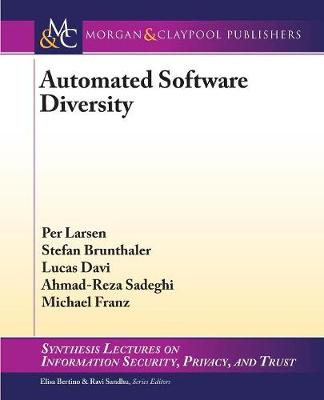Synthesis Lectures on Information Security, Privacy, and Trust
3 total works
Physically Unclonable Functions (Pufs)
by Christian Wachsmann and Ahmad-Reza Sadeghi
Published 1 December 2014
Today, embedded systems are used in many security-critical applications, from access control, electronic tickets, sensors, and smart devices (e.g., wearables) to automotive applications and critical infrastructures. These systems are increasingly used to produce and process both security-critical and privacy-sensitive data, which bear many security and privacy risks. Establishing trust in the underlying devices and making them resistant to software and hardware attacks is a fundamental requirement in many applications and a challenging, yet unsolved, task. Solutions solely based on software can never ensure their own integrity and trustworthiness while resource-constraints and economic factors often prevent the integration of sophisticated security hardware and cryptographic co-processors. In this context, Physically Unclonable Functions (PUFs) are an emerging and promising technology to establish trust in embedded systems with minimal hardware requirements.
This book explores the design of trusted embedded systems based on PUFs. Specifically, it focuses on the integration of PUFs into secure and efficient cryptographic protocols that are suitable for a variety of embedded systems. It exemplarily discusses how PUFs can be integrated into lightweight device authentication and attestation schemes, which are popular and highly relevant applications of PUFs in practice.
For the integration of PUFs into secure cryptographic systems, it is essential to have a clear view of their properties. This book gives an overview of different approaches to evaluate the properties of PUF implementations and presents the results of a large scale security analysis of different PUF types implemented in application-specific integrated circuits (ASICs). To analyze the security of PUF-based schemes as is common in modern cryptography, it is necessary to have a security framework for PUFs and PUF-based systems. In this book, we give a flavor of the formal modeling of PUFs that is in its beginning and that is still undergoing further refinement in current research.
The objective of this book is to provide a comprehensive overview of the current state of secure PUF-based cryptographic system design and the related challenges and limitations.
This book explores the design of trusted embedded systems based on PUFs. Specifically, it focuses on the integration of PUFs into secure and efficient cryptographic protocols that are suitable for a variety of embedded systems. It exemplarily discusses how PUFs can be integrated into lightweight device authentication and attestation schemes, which are popular and highly relevant applications of PUFs in practice.
For the integration of PUFs into secure cryptographic systems, it is essential to have a clear view of their properties. This book gives an overview of different approaches to evaluate the properties of PUF implementations and presents the results of a large scale security analysis of different PUF types implemented in application-specific integrated circuits (ASICs). To analyze the security of PUF-based schemes as is common in modern cryptography, it is necessary to have a security framework for PUFs and PUF-based systems. In this book, we give a flavor of the formal modeling of PUFs that is in its beginning and that is still undergoing further refinement in current research.
The objective of this book is to provide a comprehensive overview of the current state of secure PUF-based cryptographic system design and the related challenges and limitations.
Mobile Platform Security
by N. Asokan, Lucas Davi, Alexandra Dmitrienko, and Stephan Heuser
Published 1 December 2013
Recently, mobile security has garnered considerable interest in both the research community and industry due to the popularity of smartphones. The current smartphone platforms are open systems that allow application development, also for malicious parties. To protect the mobile device, its user, and other mobile ecosystem stakeholders such as network operators, application execution is controlled by a platform security architecture. This book explores how such mobile platform security architectures work. We present a generic model for mobile platform security architectures: the model illustrates commonly used security mechanisms and techniques in mobile devices and allows a systematic comparison of different platforms. We analyze several mobile platforms using the model. In addition, this book explains hardware-security mechanisms typically present in a mobile device. We also discuss enterprise security extensions for mobile platforms and survey recent research in the area of mobile platform security. The objective of this book is to provide a comprehensive overview of the current status of mobile platform security for students, researchers, and practitioners.
Automated Software Diversity
by Per Larsen, Stefan Brunthaler, Lucas Davi, and Ahmad-Reza Sadeghi
Published 23 December 2015
Whereas user-facing applications are often written in modern languages, the firmware, operating system, support libraries, and virtual machines that underpin just about any modern computer system are still written in low-level languages that value flexibility and performance over convenience and safety. Programming errors in low-level code are often exploitable and can, in the worst case, give adversaries unfettered access to the compromised host system.
This book provides an introduction to and overview of automatic software diversity techniques that, in one way or another, use randomization to greatly increase the difficulty of exploiting the vast amounts of low-level code in existence. Diversity-based defenses are motivated by the observation that a single attack will fail against multiple targets with unique attack surfaces. We introduce the many, often complementary, ways that one can diversify attack surfaces and provide an accessible guide to more than two decades worth of research on the topic. We also discuss techniques used in conjunction with diversity to prevent accidental disclosure of randomized program aspects and present an in-depth case study of one of our own diversification solutions.
This book provides an introduction to and overview of automatic software diversity techniques that, in one way or another, use randomization to greatly increase the difficulty of exploiting the vast amounts of low-level code in existence. Diversity-based defenses are motivated by the observation that a single attack will fail against multiple targets with unique attack surfaces. We introduce the many, often complementary, ways that one can diversify attack surfaces and provide an accessible guide to more than two decades worth of research on the topic. We also discuss techniques used in conjunction with diversity to prevent accidental disclosure of randomized program aspects and present an in-depth case study of one of our own diversification solutions.


